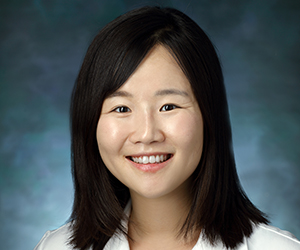 Boyoung "Bo" Ahn is a first-year internal medicine resident at Johns Hopkins Bayview Medical Center. Originally from South Korea, she earned her medical degree from the Geisel School of Medicine at Dartmouth. Bo hopes to pursue a career in primary care, geriatrics and medical education.
Boyoung "Bo" Ahn is a first-year internal medicine resident at Johns Hopkins Bayview Medical Center. Originally from South Korea, she earned her medical degree from the Geisel School of Medicine at Dartmouth. Bo hopes to pursue a career in primary care, geriatrics and medical education.
The clock read a little after midnight. Wearing my mask and gown, I walked into the patient’s room in the emergency department, marked “droplet precautions.”
A young woman lay in bed, her face partially obscured by long, dark hair. She glanced up briefly, acknowledging my presence.
Sophia was the first of my three overnight admissions to the internal medicine service. A 32-year-old woman with a history of Type 1 diabetes complicated by gastroparesis, she presented with one day of flu-like symptoms. She was diagnosed with influenza A and concurrent pneumonia. Additionally, her thyroid function tests revealed thyrotoxicosis, raising suspicion for Graves’ disease given her autoimmune history.
I asked Sophia how she was feeling.
“Tired,” she replied, followed by a dry cough. Her muscles still ached, especially in her back. However, she felt her heart was not racing as much since taking the first dose of propranolol.
The monitor showed that she was normotensive, with a heart rate in the 90s, occasionally rising into the low 100s. Her oxygen saturation remained stable on room air.
On physical exam, heart sounds were regular, though the rate remained on the higher end. Breath sounds were clear, without wheezing or crackles. As I palpated the abdomen, her thin frame settled lightly against my fingers. My gaze landed on the glucose sensor to the left of the umbilicus, connected to a worn insulin pump clipped to her waistband.
As I gently pressed on the lower extremities to check for signs of edema, I asked, “What is your support system like at home?”
There was a brief pause.
“I live alone,” Sophia said quietly.
After a moment, she added, “But I have an older brother.”
I learned that Sophia’s mother had passed away when she was a toddler. She and her brother were raised in foster care thereafter. Her brother now lived less than an hour away, but they had never been particularly close.
Sophia had recently ended a relationship with a woman after many years together. As she shared this, I saw tears well up in her eyes, which seemed to reflect both sadness and relief.
She worked as a teacher in an after-school program, mentoring disadvantaged children. “I understand them because I have been there,” Sophia said. “I truly believe they can make it through.” Her expression softened, and a faint smile appeared at the corners of her lips. “They give my life purpose.”
Talking with Sophia felt like catching up with an old friend. Maybe it was our shared age or her quiet nature that mirrored my own. Perhaps it was the way I related to her pain after a breakup or the joy she found in helping children. Yet, beneath that connection, I felt deeply naïve. I could not begin to imagine growing up without the shelter of a parent. Nor could I fathom living with a chronic disease — attached to a machine that tracked every bite, or alternating between hunger and the nausea that followed eating.
Now, a potential new diagnosis added another layer of uncertainty to her already weary body.
As residents at Johns Hopkins Bayview Medical Center, we are trained to care for each patient as a whole person. However, my intern year has taught me that fully understanding a patient’s life is beyond our reach. Instead, we gather pieces of their life — each one offering a glimpse into the myriad experiences that shape who they are.
As I sat with Sophia that night, listening to the pieces she chose to share, I was reminded once again that patients trust doctors with more than just treating their medical conditions. They trust us equally to take a genuine interest in their lives beyond the hospital walls. I see patients’ faces light up as they begin discussing loved ones. Some speak with enthusiasm about their past or present careers, while others reflect fondly on hobbies that bring them peace. Open-ended questions like “What is important to you?” uncover dimensions of their lives that are not captured in medical charts.
This perspective motivates me to be as present as possible at the bedside — to listen and learn. The best I can do for my patients is to continually strive to connect with their lives, even knowing that my understanding will always fall short.
Importantly, these seemingly ordinary conversations with patients often bring our attention back to their health and further inform our medical care. I may notice gradual declines in function over the years or emerging mental health concerns in recent weeks. Such observations enable timely interventions that are not apparent from the initial presentation. At other times, I hear about patients’ hopes for the future, ranging from short-term goals to lifelong pursuits. These insights help us align the treatment plan with their core values.
“I want to grow a garden one day,” Sophia said, her voice tinged with anticipation. “And raise my own food — natural and chemical-free — so I can finally eat without worrying about what is in it.”
The patient provided written consent for the publication of this narrative. A pseudonym was used to maintain confidentiality.
 Personomics: Knowing Each Patient As a Person
Personomics: Knowing Each Patient As a Person
“It is much more important to know what sort of a patient has a disease than what sort of a disease a patient has.” – Sir William Osler
Personomics is a blog series featuring essays from residents and clinical fellows about their experiences knowing each patient as a person. The term personomics recognizes that understanding the unique attributes and life experiences of each person and the environmental, cultural, behavioral and economic factors that influence an individual’s life are as important to patient care as genomics, proteomics, pharmacogenomics and other “–omics.” Practicing personomics makes patients feel cared for and heard; provides critical information that helps establish a diagnosis and tailor a patient’s treatment plan to the individual; and allows physicians to derive greater meaning from their work, serving as an antidote to burnout and improving well-being.
Submit an essay to Personomics
Read more Personomics blog posts
